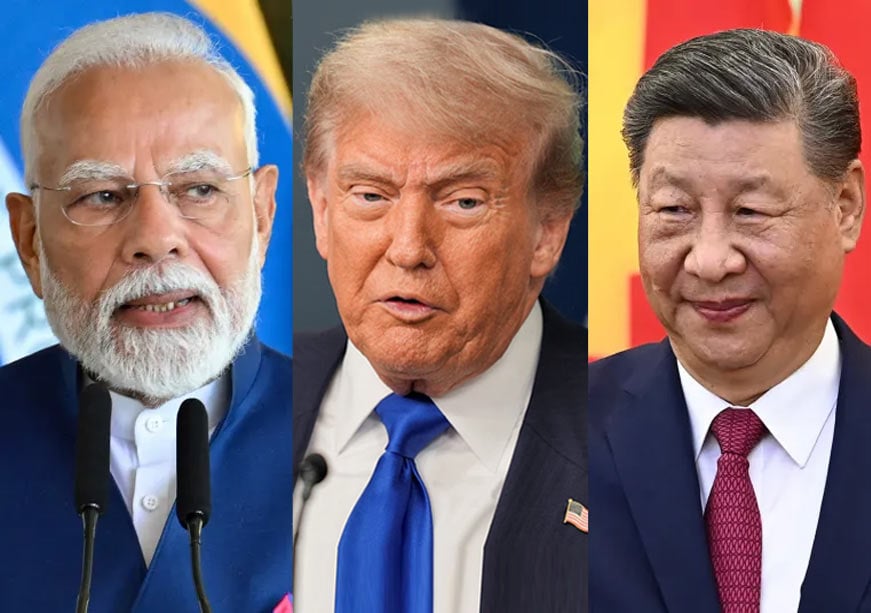By Research and Policy Officer and Visiting Fellow at Observer Research Foundation, Tushar Joshi
Prime Minister Narendra Modi’s recent visit to Tianjin on 31 August to attend the Shanghai Cooperation Organisation (SCO) summit marked his first visit to China in seven years, and his first since the deadly Galwan clash of 2020. The visit followed Chinese Foreign Minister Wang Yi’s trip to New Delhi, where he met Modi, External Affairs Minister Dr S. Jaishankar, and National Security Adviser Ajit Doval. Many commentators view this moment as a tactical hedge by New Delhi — a way of balancing deteriorating India-US ties through engagement with Beijing. Some have gone further, describing the current détente as no more than a “cold peace,” fragile and temporary.
While the Trump administration’s imposition of 50 percent tariffs on Indian exports may have accelerated this outreach, these factors alone are insufficient to explain it. This development is also shaped by deeper domestic economic imperatives that have long compelled New Delhi to stabilise its most asymmetrical bilateral relationship.
Beyond Washington: Domestic Pressures at Play
The dominant narrative situates India’s renewed engagement with Beijing within the frame of American protectionism. Trump-era tariff hikes on Indian goods, combined with sanctions pressure linked to energy imports from Russia, pushed India into a more uncertain economic position. Against this backdrop, the resumption of the Kailash Mansarovar Yatra, the reissuing of visas to Chinese nationals, and the recent prime ministerial visit are often explained as tactical moves forced by Washington’s unpredictability.
Even before US tariffs, Indian policymakers were grappling with an expanding trade deficit with China, along with growing industrial dependencies. Imports from China reached an all-time high of US$113.45 billion in FY2025, with the trade deficit widening to US$99.2 billion. Over the past 15 years, India’s imports from China have grown 2.3 times faster than imports from all other countries combined, highlighting just how entrenched this asymmetry has become.
Yet such an interpretation overlooks the structural pressures within India’s own economy. Even before US tariffs, Indian policymakers were grappling with an expanding trade deficit with China, along with growing industrial dependencies. Imports from China reached an all-time high of US$113.45 billion in FY2025, with the trade deficit widening to US$99.2 billion. Over the past 15 years, India’s imports from China have grown 2.3 times faster than imports from all other countries combined, highlighting just how entrenched this asymmetry has become.
When Restrictions Hurt at Home
This structural dependency became even more visible after the post-Galwan restrictions amplified these vulnerabilities. To demonstrate toughness on China, India slowed approvals for Chinese investments, tightened visa norms, and suspended direct flights. While these steps signalled political resolve, they carried unintended consequences for domestic businesses dependent on Chinese capital, labour, and supply chains.
The impact of restrictions was most evident in sectors critical to India’s growth strategy. The electric vehicle (EV) ecosystem, central to India’s 2030 non-fossil energy goals, relies heavily on Chinese inputs. Beijing refines nearly 90 percent of global rare earths, and when China restricted rare earth exports in April 2025, India’s EV industry faltered. Bajaj, for instance, produced just 10,824 units of its Chetak EV scooter in July, nearly halving output from a year earlier. Likewise, China’s restrictions on urea exports in 2024 led to a sharp 20 percent decline in India’s urea imports, which fell to approximately 5.7 million tonnes during the fiscal year, exposing serious risks to agricultural security.
Pharmaceuticals tell a similar story. China supplies around 70 percent of India’s active pharmaceutical ingredients (APIs). Pandemic-era disruptions, combined with bilateral frictions, laid bare the vulnerability of India’s drug manufacturing base.
Furthermore, the visa restrictions on Chinese technical workers worsened matters, with industries struggling to operationalise Chinese machinery already installed in Indian plants. Attempts by industry leaders to tackle these issues by sending Indian professionals to China largely failed due to delays in approvals from Beijing.
The suspension of direct flights between the two countries since the pandemic forced Indian traders to reroute via Southeast Asia, with nearly 60 percent of passenger demand in 2025 diverted through Hong Kong, Singapore, and Malaysia.
These disruptions also spilt over into investment. Proposals like BYD’s US$1 billion EV project in India collapsed under the weight of tightened scrutiny. Even the Economic Survey warned that Chinese investment remains essential to boosting Indian exports and addressing the widening trade deficit.
The Boundary-First Principle
Despite mounting domestic costs, India remained firm on sequencing: without progress on the boundary, a comprehensive reset was impossible. This “boundary-first principle” shaped a cautious, incremental approach. Multiple rounds of the Working Mechanism for Consultation and Coordination (WMCC) and Corps Commander-level talks sought to resolve outstanding border tensions while gradually reopening channels of engagement. The announcement of “patrolling arrangements” last year, timed just before Modi’s visit to Kazan, signalled that a calibrated normalisation was underway.
Despite mounting domestic costs, India remained firm on sequencing: without progress on the boundary, a comprehensive reset was impossible. This “boundary-first principle” shaped a cautious, incremental approach.
The subsequent chronology illustrates this approach. In October 2024, Modi and Xi Jinping met for the first time since Galwan, appreciating disengagement at key points and the resumption of patrolling and grazing. They also endorsed dialogue mechanisms to stabilise ties. A month later, Jaishankar and Wang Yi met on the sidelines of the G20 in Brazil, discussing practical issues such as river data-sharing, flights, and the Kailash Mansarovar Yatra. By December, Special Representatives’ talks were also resumed, where similar issues were discussed.
The momentum continued into 2025, marked by high-level visits to Beijing by NSA Doval in June and EAM Jaishankar in July — the first senior-level engagements since the Galwan clash. During the same month, Finance Minister Nirmala Sitharaman’s remarks that “stakeholders within India” were urging the government to ease restrictions on investments from China, alongside Beijing’s own outreach through diplomatic channels, further underscored how domestic business pressures were actively shaping diplomacy.
Signs of Re-engagement
This strategy was soon reciprocated by China. Wang Yi’s recent visit to New Delhi marked a turning point. Agreements to resume direct flights, reopen border trade through Lipulekh, Shipki La, and Nathu La, and update air service agreements directly addressed Indian business and travel concerns. Additionally, Wang Yi’s assurances on rare earths, fertilisers, and tunnel-boring machines (TBMs) reflected recognition of India’s bottlenecks. Simultaneously, Indian exporters have continued to press for greater access to Chinese markets in agriculture, pharmaceuticals, and IT services, though it remains to be seen how Beijing will respond to these demands.
The Road Ahead: Engaging with Caution
The current thaw appears more tactical than transformative. Yet, domestic economic compulsions make prolonged disengagement unrealistic. Given the deep integration in key sectors like EVs and pharmaceuticals, the existing trade imbalance is unlikely to vanish soon. For India to sustain its growth trajectory, selective and cautious re-engagement with China is unavoidable in the short to medium term. At the same time, reducing over-reliance on a country with which India shares both a trade deficit and a trust deficit, with mistrust from Galwan still lingering, is essential to safeguard long-term strategic autonomy.
Against this backdrop, several policy lessons emerge. First, India must prioritise boundary stability as the foundation for broader ties. Without political assurances, expanding trade could worsen vulnerabilities without ensuring long-term benefits.
For India to sustain its growth trajectory, selective and cautious re-engagement with China is unavoidable in the short to medium term. At the same time, reducing over-reliance on a country with which India shares both a trade deficit and a trust deficit, with mistrust from Galwan still lingering, is essential to safeguard long-term strategic autonomy.
Second, supply chain diversification through partnerships with like-minded countries is critical, even as engagement with China continues. India is already seen as a promising destination under the global “China Plus One” strategy, which encourages diversification beyond China. However, India must itself avoid over-dependence by sourcing inputs from alternative partners. Australia, for instance, alone produces 52 percent of global lithium, providing a potential source for battery inputs. While full decoupling from China is neither realistic nor beneficial, strategic diversification can help safeguard key sectors.
Third, India should promote targeted Chinese investment in non-sensitive sectors to enhance domestic capacity through technology sharing. Despite the Economic Survey 2024–25 recommendations, Chinese FDI fell to US$60.37 million in 2023 from US$148.57 million in 2013, with cumulative investment at US$2.5 billion, placing China 22nd among India’s FDI sources. This recent decline is largely attributed to restrictions under Press Note 3 of 2020, which made it necessary for border countries to seek prior approval from the government for investments from border-sharing countries. Acknowledging its adverse impact, the government recently expedited approvals in select sectors like solar energy and battery production. Studies, including one by ICRIER, suggest encouraging targeted investment in electronics, automobiles, and pharmaceuticals under the PLI scheme to support local supply chains and technology transfers.
Fourth, India must address barriers to market access, particularly non-tariff barriers (NTBs), which continue to constrain exports. India’s untapped export potential to China is estimated at US$161 billion, nearly ten times its current export value. A joint task force could be a step towards resolving these barriers, enhancing transparency, and aligning certification procedures with WTO standards. At the same time, India must strengthen its own industrial base and upgrade quality standards, as export limitations stem not only from external barriers but also from domestic gaps.
The recommendations above — stabilising borders, diversifying supply chains, encouraging selective investment, and addressing market access concerns — are not calls for unchecked cooperation but pragmatic steps to balance economic needs with national interests.
On balance, India’s re-engagement with China cannot be explained solely by US tariff pressures. India’s deep economic vulnerabilities — widening trade deficits, industrial dependencies, and trust deficits — play an equally significant role. The recommendations above — stabilising borders, diversifying supply chains, encouraging selective investment, and addressing market access concerns — are not calls for unchecked cooperation but pragmatic steps to balance economic needs with national interests. As India moves forward, it must remain cautious, ensuring that short-term trade gains do not entrench long-term dependencies.
This article was originally published in Observer Research Foundations Expert Speak.


